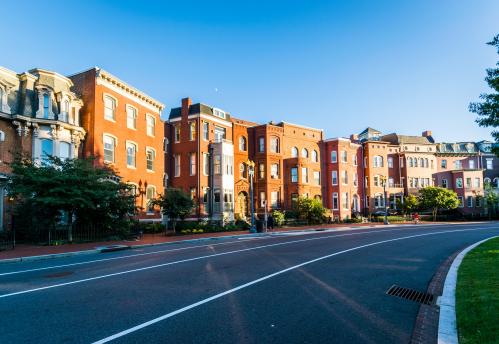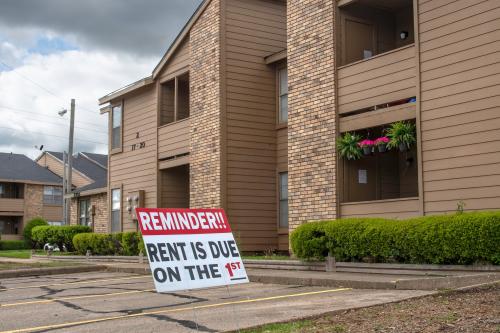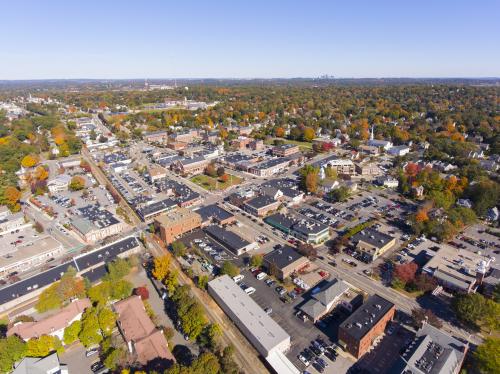America’s renters are facing a bleak winter. As of early November, 9 million of them were behind on their rent. Remaining COVID-19 unemployment insurance programs expire on December 26, while the Centers for Disease Control and Prevention’s nationwide eviction moratorium will end on December 31. And the prospects for additional federal support are uncertain.
While members of Congress are insulated from seeing the human costs of their actions—or lack of action—local governments do not have that luxury. Families unable to pay their rent will rely on services from their local government and nonprofits: lines wrapping around the block for free groceries, requests for help from neighborhood mutual aid societies, and potentially an increase in people living in their cars, vacant buildings, and public spaces.
To stave off the worst case scenario, local governments are increasingly turning to rent relief programs, dispersing a pot of funds as one-off grants to hard-up renters. The structure of these programs varies somewhat across cities: Some are intended to be used to pay rent owed, while others provide a security deposit and first month’s rent for renters who have been (or are in the process of being) evicted. In setting up these programs, cities must make a number of critical decisions about how to design and implement their policy. Thinking through policy goals, tradeoffs, and potential challenges upfront can improve programs’ effectiveness.

Cities should invest time upfront to identify goals and challenges
Cities that are creating rent relief programs for the first time and those that are expanding or modifying existing programs should spend some initial time determining what the goals of the program are, how best to achieve those goals, and forecasting some likely hurdles to implementation. Policies can vary in numerous ways; below are three of the larger decisions facing local governments.
Policy choice #1: Who is eligible to receive rent relief?
Sample eligibility criteria:
- Annual household income below some threshold (e.g., 80% of area median income)
- Loss of employment or income during the COVID-19 recession
- Not receiving other public financial benefits (e.g., unemployment insurance)
Why this matters:
Cities that had rent relief programs prior to the COVID-19 crisis often determined eligibility based on annual household income, similar to eligibility for food stamps or longer-term housing subsidies. But some renters who were above this income threshold in the previous year have lost their jobs or had hours reduced due to the pandemic. Cities that use CARES Act funds or other federal sources for their rent relief programs face some legal restrictions and ambiguities—notably around immigration status—that may hinder serving hard-hit populations.
Policy choice #2: How will the city ration funds across eligible applicants?
Sample distribution criteria:
- First come, first served until funds are exhausted
- One-time lottery among all eligible applicants
- Prioritize by applicant characteristics, such as level of economic need or families with children
Why this matters:
Even under normal economic circumstances, most cities have far more cost-burdened renters facing displacement than rent relief funds can serve. No rationing strategy is perfect. A first-come, first-served approach may unintentionally disadvantage households who do not have prior relationships with local government or service providers, and therefore lack information to apply early. A one-time lottery has some advantages in being able to conduct timely outreach to all eligible households, and may also help local governments quantify unmet need (e.g., how many eligible applicants did not receive funds), which could assist in requesting additional funds from state and federal sources or philanthropies. Of the 25 cities surveyed for this analysis, nearly half of program websites state that they have already exhausted their funds (Figure 1).
Policy choice #3: What does the application process involve?
Sample application materials:
- Annual income from prior year
- Proof of loss of income or financial hardship during pandemic
- Notice of eviction filed by landlord or landlord’s willingness to participate in program
Why this matters:
Subsidy programs that have a higher administrative burden—requiring applicants to produce extensive documentation or apply in-person during set times—will discourage some eligible applicants. Many of the population groups that job losses have hit especially hard—low-wage workers, immigrants, and Black and Latino or Hispanic households—have low levels of trust in government, which may make them reluctant to share personal information. While online applications offer greater safety during the pandemic, many low-income households do not have reliable internet service or access to computers to scan and upload documents, especially while resource centers such as public libraries and schools are closed. Cities should also consider the demands that reviewing documentation and vetting applicants will place on their staff, at a time when local budgets are especially strained.
Keep the big picture in mind: Stable, affordable housing
Beyond these specific elements of designing and implementing a rent relief program, cities should think about how these programs fit into their overall local housing ecosystem.
How do rent relief programs interact with other local housing programs?
COVID-19 has cast a harsh spotlight on existing gaps in the social safety net, including housing supports. Landlord-tenant laws vary across states and localities, creating an uneven patchwork of tenant protections such as landlord-tenant mediation programs, right to counsel, and the overall transparency and accountability of eviction processes. Evictions are typically handled through county court systems, while rent relief programs are generally administered by executive agencies that report to mayors. That makes it more difficult to align financial supports with legal protections for renters. Many cities rely on different agencies to administer federal, state, and local housing subsidies and homelessness prevention programs. Designating a single point of contact within the local government could help coordinate and integrate various programs.
One-time rent relief cannot substitute for long-term housing subsidies
Low-income renters faced high housing cost burdens and unstable housing conditions prior to COVID-19. For these households, a one-time grant is not enough to offer them stable, affordable homes; access to federal housing vouchers and space in below-market-rate housing are better long-term solutions. While local governments have severely limited resources to expand permanent housing subsidies during the pandemic, they need to keep reasonable expectations about what short-term rent relief funds can accomplish.
Collect data, monitor performance, and tweak programs when necessary
In the midst of twin public health and economic crises, it’s difficult for local governments to find time, resources, and bandwidth to assess how well their policies are working. But ongoing evaluation is essential in making sure the programs achieve their goals and use limited resources effectively. To do this, local governments should develop a plan from the beginning to monitor outcomes at each stage of the program. Are applications lower than expected? Does the pool of applicants seem representative of low-income renters in the city? Are some eligibility criteria harder to document? Cities should watch for early warning signs that programs aren’t working as anticipated, and be ready to tweak policies as needed. While not all cities have staff with the time or training to conduct this type of monitoring, many universities have research centers with expertise in housing policy and program evaluation, which may be able to help.
Thoughtful upfront design of rent relief programs and careful monitoring during program roll-out can help improve the effectiveness of these programs, and provide more stability to vulnerable renters as they enter an uncertain period of the COVID-19 crisis.
-
Acknowledgements and disclosures
Michael Zhu provided excellent research assistance for this analysis.






Commentary
To weather the coming eviction crisis, cities need better rent relief programs
December 8, 2020